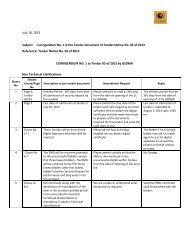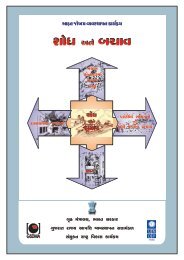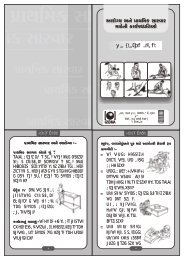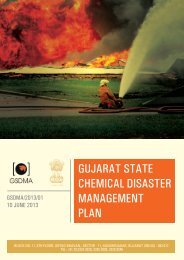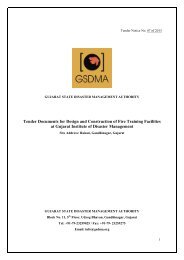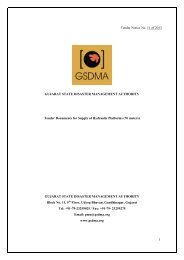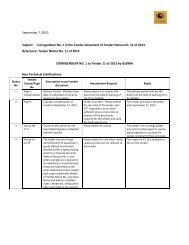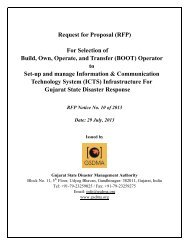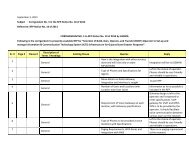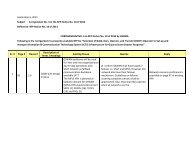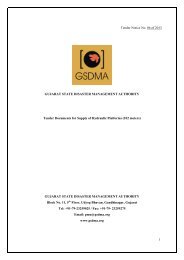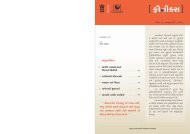Emergency Response Guidebook - Gujarat State Disaster ...
Emergency Response Guidebook - Gujarat State Disaster ...
Emergency Response Guidebook - Gujarat State Disaster ...
Create successful ePaper yourself
Turn your PDF publications into a flip-book with our unique Google optimized e-Paper software.
PGpHPIHPolarPolymerizationppmProtective clothingPyrophoricSee Packing GroupGlossarypH is a value that represents the acidity or alkalinity of a water solution.Pure water has a pH of 7. A pH value below 7 indicates an acid solution (apH of 1 is extremely acidic). A pH above 7 indicates an alkaline solution (apH of 14 is extremely alkaline). Acids and alkalies (bases) are commonlyreferred to as corrosive materials.Poison Inhalation Hazard. Term used to describe gases and volatile liquidsthat are toxic when inhaled. (Same as TIH)See “Miscible”.This term describes a chemical reaction which is generally associated withthe production of plastic substances. Basically, the individual moleculesof the chemical (liquid or gas) react with each other to produce what canbe described as a long chain. These chains can be formed in many usefulapplications. A well known example is the styrofoam (polystyrene) coffeecup which is formed when liquid molecules of styrene react with eachother or polymerize forming a solid, therefore changing the name fromstyrene to polystyrene (poly means many).Parts per million. (1 ppm equals 1 mL/m3)Includes both respiratory and physical protection. One cannot assign alevel of protection to clothing or respiratory devices separately. Theselevels were accepted and defined by response organizations such as U.S.Coast Guard, NIOSH, and U.S. EPA.Level A:Level B:Level C:Level D:SCBA plus totally encapsulating chemical resistant clothing(permeation resistant).SCBA plus hooded chemical resistant clothing (splash suit).Full or half-face respirator plus hooded chemical resistantclothing (splash suit).Coverall with no respiratory protection.A material which ignites spontaneously upon exposure to air (or oxygen).Radiation AuthorityRadioactivityRefrigerated liquidSmall spillGlossaryAs referred to in GUIDES 161 through 166 for radioactive materials, theRadiation Authority is either a Federal, state/provincial agency orstate/province designated official. The responsibilities of this authorityinclude evaluating radiological hazard conditions during normaloperations and during emergencies. If the identity and telephonenumber of the authority are not known by emergency responders, orincluded in the local response plan, the information can be obtained fromthe agencies listed on the inside back cover. They maintain a periodicallyupdated list of radiation authorities.The property of some substances to emit invisible and potentially harmfulradiation.See “Cryogenic liquid”.A spill that involves quantities that are less than 208 liters for liquids andless than 300 kilograms (660 pounds) for solids.Straight (solid) stream Method used to apply or distribute water from the end of a hose. Thewater is delivered under pressure for penetration. In an efficient straight(solid) stream, approximately 90% of the water passes through animaginary circle 38 cm (15 inches) in diameter at the breaking point. Hose(solid or straight) streams are frequently used to cool tanks and otherequipment exposed to flammable liquid fires, or for washing burningspills away from danger points. However, straight streams will cause aspill fire to spread if improperly used or when directed into opencontainers of flammable and combustible liquids.TIHVVapour densityToxic Inhalation Hazard. Term used to describe gases and volatile liquidsthat are toxic when inhaled. (Same as PIH)Saturated Vapour concentration in air of a material in mL/m3 (volatility)at 20oC and standard atmospheric pressure.Weight of a volume of pure Vapour or gas (with no air present) comparedto the weight of an equal volume of dry air at the same temperature andpressure. A Vapour density less than 1 (one) indicates that the Vapour islighter than air and will tend to rise. A Vapour density greater than 1 (one)indicates that the Vapour is heavier than air and may travel along theground.Vapour pressurePressure at which a liquid and its Vapour are in equilibrium at a giventemperature. Liquids with high Vapour pressures eVapourate rapidly.Page 382Page 383



